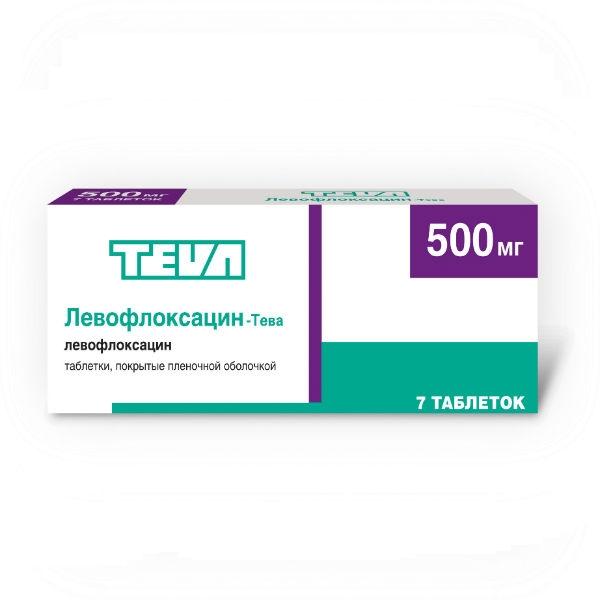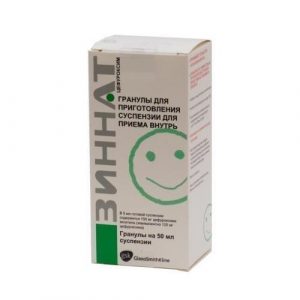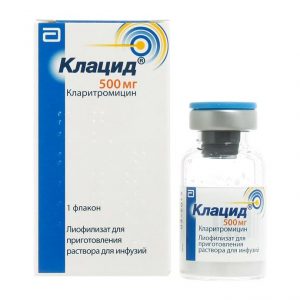Description
film release
film-coated tablets
Packing
7 pcs
Pharmacological action
The optically active levorotatory isomer of ofloxacin – L-ofloxacin (S – (-) – enantiomer). It has a wide range of antimicrobial activity. Blocks bacterial topoisomerase IV and DNA gyrase (topoisomerase II). It disrupts the supercoiling and cross-linking of DNA breaks, and causes deep morphological changes in the cytoplasm and cell wall. In concentrations equivalent or in excess of the minimum inhibitory concentration (MIC), most often has a bactericidal effect. The main mechanism for the development of resistance is associated with a mutation of the gyr-A gene with the possible development of cross-resistance between levofloxacin and other fluoroquinolones. Cross-resistance between levofloxacin and other classes of antibacterial drugs usually does not occur.
Indications
Infectious and inflammatory diseases caused by microorganisms sensitive to levofloxacin: acute bacterial sinusitis
exacerbation of chronic bronchitis
community-acquired pneumonia
complicated infectious diseases of the kidneys and urinary tract, including pyelonephritis
chronic bacterial prostatitis
infections of the skin and soft tissues.
Special instructions
When applying levofloxacin, there have been cases of tendonitis, which affects mainly the Achilles tendon and can lead to rupture. In elderly patients, as well as with concomitant use of corticosteroids, the likelihood of tendonitis and tendon rupture with levofloxacin increases. If suspected of tendonitis, levofloxacin should be immediately withdrawn and appropriate treatment should be initiated, ensuring dormancy in the affected area.
If pseudomembranous colitis is suspected (the occurrence of diarrhea, in particular severe and / or blood), levofloxacin should be stopped immediately and appropriate treatment should be started.
During treatment with levofloxacin, seizures may develop in patients with previous brain damage (including with a stroke or severe brain injury).
With the use of quinolones in patients with glucose-6-phosphate dehydrogenase deficiency, erythrocyte hemolysis is possible.
If it is necessary to use levofloxacin in patients with diabetes mellitus, it is necessary to control the concentration of glucose in the blood.
Sometimes, even after taking the first dose of levofloxacin, the development of severe, potentially dangerous hypersensitivity reactions (angioedema, anaphylactic shock) is possible.
Although photosensitization is very rare with levofloxacin, patients should avoid exposure to the sun or UV radiation to prevent it from developing.
With the simultaneous use of levofloxacin and indirect anticoagulants, it is necessary to monitor the state of the blood coagulation system.
When taking fluoroquinolones, including levofloxacin, the development of psychotic reactions is possible, which, very rarely, with progression can lead to suicidal thoughts and potentially dangerous behavior. With the development of such phenomena, the drug should be discontinued.
When applying levofloxacin in patients who have predisposing factors for lengthening the QT interval, it is necessary to conduct an electrocardiogram study before and during treatment with levofloxacin.
When taking fluoroquinolones, there have been cases of the development of sensory or sensorimotor peripheral neuropathy. To prevent the development of irreversible effects in the development of symptoms of peripheral neuropathy, levofloxacin should be immediately canceled.
When taking levofloxacin in patients, false-positive test results for the presence of opiates in the urine are possible. More specific methods should be used to confirm a positive test result.
There are reports of rare cases of liver failure during treatment with levofloxacin, primarily in patients with severe diseases such as sepsis. When symptoms of liver dysfunction appear, such as decreased appetite, jaundice, dark urine, itching or tenderness of the abdominal wall upon palpation, levofloxacin should be discontinued.
When prescribing the drug to elderly patients, it should be borne in mind that patients in this group often have impaired renal function.
Composition of
1 tablet contains: active substance levofloxacin (levofloxacin hemihydrate) 500.00 (512.46) mg excipients: silicon dioxide colloidal 12.00 mg, hyprolysis 28.00 mg, carboxymethyl starch sodium, type A 55.00 mg, talc 55.20 mg, croscarmellose sodium 20.60 mg, magnesium stearate 6.74 mg, Opadry 15V26688 brown shell (hypromellose 2910 3 CP 4.760 mg, hypromellose 2910 6 CP 4.760 mg, titanium dioxide E171 3.044 mg, macrogol-400 1.120 mg, polysorbate-800.140 mg, iron dye yellow oxide E172 0.120 mg, iron dye red oxide E172 0.043 mg, dye iron oxide black E172 0.013 mg).
Dosage and administration of
Levofloxacin-Teva taken orally 1-2 times a day. The dose and duration of treatment are determined by the nature and severity of the infection, as well as the sensitivity of the alleged pathogen. Tablets should be taken without chewing and drinking plenty of fluids (from? To 1 cup). When choosing doses, tablets can be broken along the dividing groove into equal parts. The drug can be taken before meals or at any time between meals.
Treatment with Levofloxacin-Teva is recommended to continue for at least 48-72 hours after normalization of body temperature or after significant pathogen eradication.
Acute bacterial sinusitis: 1 tablet (500 mg) once a day for 10-14 days.
Acute bronchitis and exacerbation of chronic bronchitis:? -1 tablet (250-500 mg) 1 time per day for 7-10 days.
Community-acquired pneumonia: 1 tablet (500 mg) 1-2 times a day for 7-14 days.
Complicated infectious diseases of the kidneys and urinary tract, including pyelonephritis: by? tablet (250 mg) 1 time per day for 7-10 days.
Chronic bacterial prostatitis: 1 tablet (500 mg) once a day for 28 days.
Infections of the skin and soft tissues: 1 tablet (500 mg) 1-2 times a day for 7-14 days.
Patients with impaired hepatic function do not require dosage adjustment.
Patients with impaired renal function (CC less than 50 ml / min) require correction of the dosage regimen depending on the value of CC.
Drug interaction
Absorption of levofloxacin is significantly reduced when used with sucralfate, magnesium or aluminum-containing antacids, and also with iron salts (the interval between taking levofloxacin and these drugs should be at least 2 hours). No interactions were detected with calcium carbonate.
Quinolones can enhance the ability of drugs (including theophylline) to lower the threshold of convulsive readiness. With concomitant use with fenbufen, higher levofloxacin concentrations (13%) were observed than with monotherapy.
Excretion of levofloxacin slows down under the action of cimetidine (24%) and probenecid (34%).
Levofloxacin causes a slight increase in T1 / 2 of cyclosporine.
Concomitant use with glucocorticosteroids (GCS) increases the risk of tendon rupture.
Concomitant use of levofloxacin with oral anticoagulants increases the time of coagulation and / or bleeding.
Levofloxacin with simultaneous use with antiarrhythmic drugs of classes IA and III, tricyclic antidepressants, macrolides can cause an extension of the QT interval.
Overdose
Symptoms: nausea, erosive lesions of the mucous membranes of the gastrointestinal tract, dizziness, clouding of consciousness and seizures of the type of epileptic seizures.
Treatment: conduct symptomatic therapy, ECG monitoring. There is no specific antidote. Hemodialysis is not effective.
Storage Conditions
At a temperature not exceeding 25 ° C in a dark place. Keep out of reach of children.
Expiration
3 years.
active substance
Levofloxacin
Terms of dispatch from
pharmacies Prescription
PMA pills
Prescribing
Adults as prescribed by a doctor
Indications
Indications
From inflammation of the lungs, From skin infections, From inflammations of the female genital organs, From boils, From otitis media, Urinary tract infections, Bronchitis, From sinusitis, From urinary tract infections, From respiratory tract infections
Teva Pharmaceutical Enterprises Co., Ltd., Israel




